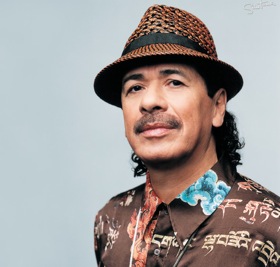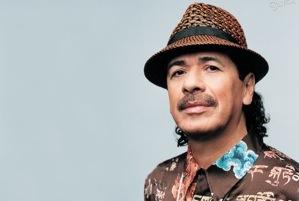
Carlos Santana doesn't stray far from his home in Tiburon to perceive the wonders of classical collaboration. “I look at the symphony like going to Mount Tamalpais on a clear day,” he enthuses during a brief phone chat. “You can see from Sacramento all the way to Maui, the violins being the sky, the cellos the earth.”
The legendary rock ’n’ roll guitarist won’t have to look that far for a landmark gig with the Oakland East Bay Symphony (OEBS), set for Nov. 19 and 20 at Oakland’s Paramount Theatre. And it seems somehow right to have exciting new things going down so close to where Santana went through public school as a teen (James Lick Middle School and Mission High, in San Francisco), and where his Santana Blues Band got its first bookings in the ’60s, alongside the Grateful Dead and Sly & the Family Stone.
“Here’s where the Black Panthers and César Chavez and Dolores Huerta and the hippies happened,” Santana points out, in an accent slightly flavored by his birth and early childhood in Mexico. “The beautiful thing about the Bay Area is that we’re not sheep, we don’t go baaaaa and follow other people. The Bay Area is the Atlantis of today, like it or not. Person for person, there’s more artists than con artists.”
Listen to the Music
And it’s Ground Zero for exploring “the willingness to become one,” as Santana puts it, “with the textures of violins, flutes, cellos, all of that, in a setting which young people can relate to. Even though I’m 63, I think that, if the symphony has willingness, then they can invite younger people to the concert by the conscious choice of music that they select. If you only play Beethoven, you’re only gonna get a certain generation. But whether it’s Santana music, Doors music, Miles Davis music, or Led Zeppelin music in context with a symphony, like Metallica did [with the San Francisco Symphony in 2000], then you get the young people. And by the time you introduce them to Leonard Bernstein and Stravinsky, it won’t be so ‘far.’ For me, nothing is far, because I’m on this planet, and everything I do is human music.”
Santana is glad to be asked about his future in the classical arena, confiding that he aspires to a coast-to-coast tour of gigs “with different symphonies” in the New Year. “There are climaxes which are extremely delightful,” he says, “and it’s not just having an orgasm and eating good food. There are other experiences, about fulfillment and bliss and peace of mind, that can be attained through the sound of a symphony, because the orchestra is so thorough and so vast.”
Although they’ve never before shared a program, Santana and OEBS Music Director Michael Morgan sound in tune. “Carlos’ part is the idea of bringing people together, across lines, and that fits right into the mission of this orchestra,” says Morgan, taking a break in his Piedmont studio. “Any new project, any new round of commissions, is always focused on looking around and seeing who is not in the room, what part of the community is not being represented in the concert hall, and what we can do to attract them.” This month’s program showcases the Irvine Foundation’s intention, extended over several seasons, to “commission people who’d never written for orchestra before, and to take each of them and pair them with a composer who’s written a lot for orchestra, just to help them with the mechanics.” Santana will be the featured soloist in The Enchanted Forest: Seven Higher Worlds of Music, composed by Marin-based, multi-Grammy-winning producer, songwriter, and drummer Narada Michael Walden, with assistance from the San Francisco Conservatory’s David Conte and Minna Choi of the Magik*Magik Orchestra.
In seven movements, the new Walden piece follows a journey of spiritual discovery and devotion familiar both to the composer and to Santana, who shared an erstwhile guru, Sri Chinmoy, in the ’70s. At the time of our chat, Santana, who’d recently returned from touring behind Guitar Heaven: The Greatest Guitar Classics of All Time (Arista Records), was looking forward to Walden’s return from his own tour, so that Santana could “get into the spiritual bathtub he’s talking about, so I can get all wet.” The guitarist shares his excitement about his three other offerings with the OEBS. “One is called Andromeda’s Suffering, by Alice Coltrane [the late wife of John Coltrane]; she’s one of my mentors. Then there’s While My Guitar Gently Weeps, which was done by Yo-Yo Ma and [vocalist] India.Arie [on the Guitar Heaven CD]. That song is by [Beatle] George Harrison, whose music is very relevant because it deals with consciousness; it doesn’t deal with being cute or anything like that.
“And there will be a song I wrote, called “Novus,” that we did with Mr. Plácido Domingo,” on Santana’s 2002 Arista album, Shaman; here, the tenor vocals will be delivered by the celebrated Oakland-bred Kalil Wilson. “Each one of these [three] songs is designed to uplift you,” affirms Santana. “Most people, if not all people, they need, like, a jump-start, to be reminded that you, me, everyone is significant and meaningful, everyone matters, ’cause we can all make a difference in the world.”
Maestro Morgan is content, and characteristically modest, about assisting with this incoming musical mission. “It’s one of the challenges of dealing with both Narada and Carlos,” he says, “that you have all these ideas floating around that you’re not sure you can even do justice to — the ideas are so big that you’re not sure you can bring them into the context of just a piece of music.” Yet he has a history of cross-genre collaboration, dating back not only to a bicentennial concert of Sousa and Ellington in his native Washington, D.C., and to a performance of Gershwin’s Rhapsody in Blue, featuring jazz pianist Marcus Roberts, during his Chicago days, but even further to “when I was a [Leonard] Bernstein student, and he was always pulling everything together. If you look at a piece like the Bernstein Mass (which we have done several times at the OEBS), there’s some of every kind of music in it. So you use whatever you’re doing to bring people together.”
In this spirit, the program at the Paramount will also include the Danzón No. 2 by Mexican composer Arturo Márquez. “It’s one of the very most-played pieces in Latin America, and it seemed like a good choice for an opening,” Morgan points out. Although it hasn’t been heard much in these parts, Morgan previously presented it with his Sacramento Philharmonic Orchestra and the Oakland Youth Orchestra, which “played the piece recently on its opening concert of the season, and we had a cameraman there from Channel 14, Spanish-language television, which never covers those concerts.”
A local welcome will be warmly received by Marinites Walden and Santana, Morgan believes. “And it makes a difference, because of the history and social dynamics, that it’s Oakland, as opposed to any of the other cities in the Bay Area,” says the conductor. “It makes a difference when people in Oakland try to do these cross-cultural things. It’s always clear that people in Oakland really mean it — that they’re not out to score points, it’s not in a condescending way. That’s what Oakland is: a big place where a lot of people want it to work, and sometimes it does and sometimes it doesn’t, but here we are.”
Santana views the same purpose from a slightly higher plane. “Most people have a lack of self-worth; most people are invested too much in sin and fear,” he declares. “And all that stuff is illusion. You, Jeff, like me: You’re made out of light and love, before your mom and your dad, you know? So, when we play music, just the frequency and resonance of all those sounds remind you of who you always have been, never not have been, and always will be. Oooooh,” he exclaims, “that’s a mindful!”

